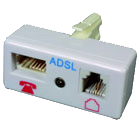Generally speaking
the terms "micro-filter", "splitter" and "ADSL filter" mean the same thing.
When your telephone line
is ADSL enabled it is able to carry information on different frequency ranges:
ADSL uses the higher frequencies to transmit data, whilst voice uses the lower frequency band.
Although you will still be able
to use your telephone as normal once your line is activated, the transmission
of adsl data on the line will cause interference.
In order that the adsl data does not interfere with the normal voice
data (and vice-versa), you need to ensure you install a filter on each device that uses the lower
frequencies. These devices are telephones, fax machines, answer phones,
sky boxes.
An ADSL filter (low pass filter) strips out any high frequency data signals which are
being carried on your phone line from the telephone side of the filter.
There are different types of splitter available for purchase, but
they all essentially work in a similar way. However, it should
be pointed out that some of the cheaper filters available are not
as reliable as others, and are not able to filter or terminate the
data signals as effectively as they should. NTE5 adsl filtered faceplates are generally the most effective since they filter your connection at the point of entry.
| Some
common types of adsl filters |
 |
 |
 |
|
Type 1
(T-Filter)
|
Type 2
(Dongle)
|
adsl NTE5 Faceplate
|
Filters will also "terminate"
your ADSL line properly by ensuring that data is not reflected back
down the phone line which could cause connection problems.
A maximum of four microfilters can be used on a BT phone
line. This corresponds to the recommended maximum number of items
of telephony equipment you can plug into a standard voice line - known
as the maximum Ringing Equivalent Number (REN).
See the next page on how to install
adsl micro-filters.
|




